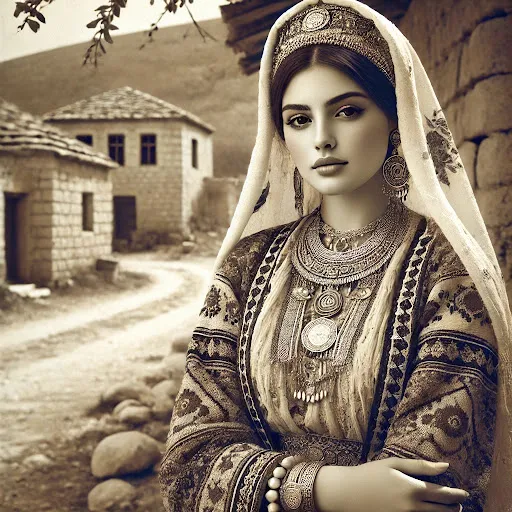The Unyielding Spirit of the Yezidis: A Glimpse into 1946 Through Anthony Kersting’s Lens
The Unyielding Spirit of the Yezidis: A Glimpse into 1946 Through Anthony Kersting’s Lens
In the vast archives of historical photography, there exist images that do more than just document—they speak, they resonate, and they remind us of the resilience of human identity. One such powerful image is the 1946 portrait of a Yezidi girl, captured by the legendary British photographer Anthony Kersting. A single frame, yet within it lies the story of an ancient people, their struggles, their traditions, and their unwavering spirit.This photograph is not just a moment frozen in time; it is a testament to the enduring soul of the Yezidi community. From her intricately embroidered dress to the depth in her eyes, the young girl in the image represents a civilization that has withstood persecution, exile, and war while fiercely preserving its unique cultural heritage.
The Yezidis: A People of Deep-Rooted Heritage
The Yezidis are an ethno-religious group with origins tracing back thousands of years. Nestled in the heart of Mesopotamia, their beliefs are a blend of ancient Zoroastrian, Sufi, and indigenous Mesopotamian traditions. Their faith is centered on the worship of Tawûsê Melek, the Peacock Angel, and their religious practices have remained largely untouched by the influences of dominant world religions.
Throughout history, the Yezidis have faced waves of persecution, yet they have remained steadfast, holding onto their traditions with remarkable resilience. Their villages, often built in the rugged mountainous terrains of modern-day Iraq, Syria, and Turkey, became sanctuaries where their customs, language, and sacred rituals flourished in seclusion.
Anthony Kersting’s 1946 photograph provides a rare visual documentation of this heritage. It is a reminder of a time when the Yezidis, despite their isolation and historical challenges, continued to celebrate their identity through dress, language, and tradition.
Decoding the Photograph: A Story Woven in Threads and Expressions
1. The Traditional Attire: A Symbol of Identity
The young girl in Kersting’s photograph is draped in a richly embroidered dress, a hallmark of Yezidi craftsmanship. Every pattern tells a story—some designs symbolizing protection, others representing nature, spirituality, or familial ties.
Her headscarf, carefully wrapped, signifies not only modesty but also spiritual reverence. The Yezidis place deep cultural and religious importance on head coverings, particularly among women, as a sign of respect and devotion. The fabric, likely handmade, carries within its fibers the skill of generations, passed down from mother to daughter in a tradition as old as the Yezidi faith itself.
2. The Eyes: A Silent Narrative
Beyond her attire, it is her eyes that captivate the viewer. There is a depth, a quiet strength, and perhaps even a shadow of sorrow—emotions that mirror the collective experiences of the Yezidi people.
In that era, the Yezidis lived largely removed from mainstream society, often regarded with suspicion due to misunderstandings of their religious beliefs. Their existence was one of both pride and caution—pride in their ancient customs and caution due to centuries of targeted oppression. This duality is palpable in the girl’s gaze. She is young, yet her expression carries the weight of a thousand stories.
Anthony Kersting: The Photographer Who Captured Forgotten Histories
Anthony Kersting (1916–2008) was more than just a photographer; he was a visual historian. His travels across the Middle East, particularly in the 1940s, documented cultures, architecture, and people whose ways of life were on the brink of change.
His ability to capture the soul of his subjects is evident in his photograph of the Yezidi girl. Unlike many Western photographers of his time, who often depicted the East through an exoticized or colonial lens, Kersting’s work was marked by sensitivity and authenticity. He didn’t just take pictures—he preserved legacies.
This image remains one of the most significant visual records of Yezidi culture in the mid-20th century, offering an unfiltered glimpse into a world that has since been dramatically altered by war, migration, and modernization.
The Yezidis in the Modern Era: A Legacy of Strength
Today, the Yezidis continue to fight for their survival—not just physically, but culturally. The ISIS-led genocide of 2014 devastated the Yezidi population, leading to mass displacement, destruction of religious sites, and the abduction of thousands of Yezidi women and children. Yet, even in the face of such atrocities, the Yezidi spirit remains unbroken.
Communities in Iraq, Armenia, and the diaspora work tirelessly to keep their heritage alive. Temples like Lalish, the holiest site in Yezidism, still stand as places of pilgrimage. Traditional songs, prayers, and rituals are being documented for future generations. And voices from within the community are finally being heard on global platforms, demanding recognition, justice, and the right to exist without fear.
Kersting’s photograph is more than a piece of history; it is a call to remember. It urges us to acknowledge the beauty of a culture that has survived against unimaginable odds. It reminds us that every thread in that young girl’s dress, every line on her face, and every flicker in her eyes represents an entire civilization’s defiance against erasure.
Why This Photograph Matters More Than Ever
In a world increasingly obsessed with digital immediacy, historical photographs like Kersting’s serve as powerful anchors to the past. They force us to slow down, to observe, and to reflect.
This image is not just about one girl; it is about a people. It is about survival, about cultural preservation, and about the universal human right to exist with dignity.
As we share this piece of history today, let it be a reminder: The Yezidis are not a forgotten people. Their story is still being written, and their voices still deserve to be heard.



Comments
Post a Comment
Thanks for messaging Aradhya Study Point.
We will reply as soon as possible.